If you live in an apartment or condo with no outdoor space, growing vegetables indoors may seem like a pipe dream, but it's entirely possible if you choose the right crops and have a few handy vegetable growing tools.
Growing vegetables can be a big part of your indoor gardening ideas, and being able to cook with produce that you've grown yourself can be very rewarding. When considering growing vegetables indoors, look for cool season plants that can tolerate some shade, like leafy greens. While most vegetables require heat and plenty of sunlight to produce a crop, some are less demanding and therefore much easier to get started with.
Indoor growing technology has advanced by leaps and bounds in recent years. It's up to you whether you opt for a full hydroponic system like this one from Amazon, or go with a more basic kit. Either way, it's totally possible. If you're ready to give it a try, we spoke to growing experts to find out the best vegetables you can grow indoors and the conditions they need to thrive.
(Image credit: Getty/Alexander Spatari)
Indoor vegetable garden care tips
Here are some general care tips from professional gardener Matthew Wilson that can be applied to all of the crops on this list if you're growing them indoors.
Check your crops regularly:
You should always inspect your plants for signs of pests and other diseases. This will help prevent infected plants or leaves from spreading to other parts of your indoor garden.
Improve air circulation:
Proper drainage in the soil and ventilation for your plants will prevent mold and mildew from developing. If you notice circulation problems, placing a small fan near the plants can help improve airflow.
Ensure equal growth through rotation.
When exposing growing vegetables to sunlight, make sure to rotate them every 2-3 days so that all sides of the plant are exposed to the light, this will encourage even growth and not just one side.

Social Links Navigation
Professional Gardener
Matthew Wilson is a professional gardener and owner of Handygardeners.com. Handy Gardeners offers a range of gardening services to customers, including garden maintenance, landscaping and planting.
1. Spinach
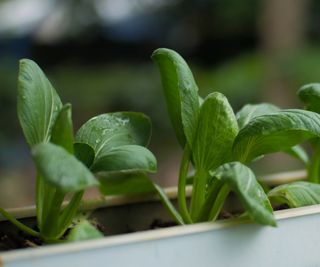
(Image credit: Bagus Satria/Getty Images)
According to Anna Hackman of The Naked Botanical, “Bloomsdale” and “Baby's Leaf” are two types of baby spinach that grow well indoors.
Anna suggests starting by gathering small containers (preferably with drainage holes, like these ceramic planter pots from Amazon) and adding a generous amount of organic potting soil, such as Espoma organic potting soil mix from Amazon.
Sprinkle the spinach seeds on top of the potting soil and cover lightly with soil.
Light Requirements: Spinach needs about 12 hours of light to grow. Place the container near a window where it gets direct sunlight or use an artificial light source.
Watering: The soil should be kept moist but not soggy. Water the plant and soil thoroughly when the topsoil is dry.
Harvesting: Wait until the leaves are 3 to 4 inches long and harvest the spinach by cutting from the outer sections, leaving the inner leaves to grow.

Social Links Navigation
Founder of Naked Botanicals
Anna is a retired Master Gardener from Rutgers University who has been gardening for over 18 years and is the founder of the blog Green Talk, where she shares tips and advice on green living, organic gardening, and more.
2. Radish
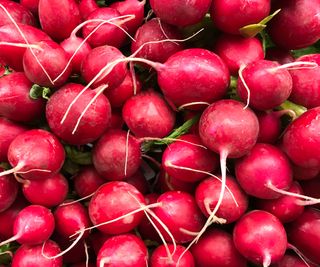
(Image credit: Getty/Howard Grill)
Radishes are another crop that can be grown indoors, and although they are typically grown for their roots, the leaves can also be harvested and eaten.
Look for small, round varieties rather than elongated varieties, which can thrive in just a few inches of soil. The best thing about growing radishes is that, with the right growing conditions, they can go from seed to harvest in less than a month.
First, select an early-maturing radish variety such as “Cherry Belle” or “French Breakfast.”
Make sure the container is at least 6″ deep. Transplant the seeds into loose potting soil. Plant seeds 1/2 inch deep and space them 1 inch apart in each row.
Light requirements: Make sure your radish plants get 6-8 hours of direct sunlight, if this isn't possible use artificial grow lights.
Watering: The soil should be kept moist but not soggy. Radishes grow best when planted in slightly moist soil.
Harvesting: For best flavor, radishes should be harvested when the roots are properly developed and about an inch thick.
3. Lettuce
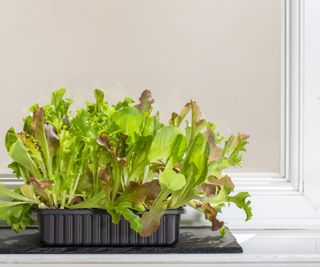
(Image courtesy of Getty/Ian Dyball)
Leaf lettuce grows best when temperatures are around 70° F. This temperature is comfortable for most homes, making it ideal for growing indoors.
Lettuce has shallow roots, making it a good choice where space is limited. Sow seeds on the soil surface and cover lightly with topsoil. Germination usually takes 1 to 2 weeks, but some varieties can be harvested in 30 days. For a continuous supply of lettuce, harvest the outer leaves as the plants grow.
Light requirements: Lettuce requires about 10-12 hours of light each day. Place growing lettuce seedlings in a windowsill where they will get plenty of sunlight.
Watering: Growing lettuce plants should be watered when the soil feels dry to the touch, to keep the soil moist at all times.
Harvesting: Once your lettuce plants have grown, cut off the outer leaves to make room for new leaves to grow.
4. Spring onion
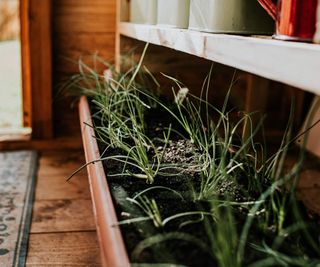
(Image credit: Getty Images/Catherine Falls Commercial)
Spring onions can be grown indoors and harvested as whole onions or you can use just the green parts.
There are several varieties of leeks that grow well indoors, including ‘Evergreen Bunching’ and ‘White Lisbon.’ One of the most common ways to sow leeks is to plant the seeds in small pots 1/4 inch deep and 1 inch apart, allowing each plant plenty of space to grow.
Light requirements: Onions need sunlight to grow and do best with at least 6-8 hours of sunlight or an artificial light source. There are many artificial light sources on the market, but we recommend the GooingTop LED Grow Light from Amazon.
Watering: Leek plants need plenty of watering, but be careful not to overwater as this can lead to mold growth. Leeks prefer a moister soil.
Harvesting: Leeks are ready to be harvested when the green part of the plant grows to a height of 6 inches. Cut off the green part leaving the white part at the base so the leeks can regrow.
5. Cherry tomatoes
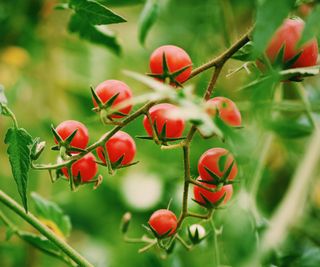
(Image credit: Getty/Emilia Manevska)
All tomatoes can be grown indoors, but some varieties require more effort than others. Cherry tomatoes are one of the easier varieties to grow indoors. Start by planting cherry tomato seeds in a pot or seed tray with good drainage.
Tomatoes grown indoors are not automatically pollinated like outdoor crops, so you may need to hand-pollinate them in order to produce fruit. Our guide to hand-pollinating plants has lots of helpful tips. This can be as simple as gently rubbing the pollen from flower to flower with a soft toothbrush, paintbrush or cotton swab.
Placing your plants next to an open window may provide just the natural breeze that will do the trick.
Light requirements: Tomatoes need lots of sun. For optimal growing conditions, they usually need 12-16 hours of sun each day. During the summer, place growing cherry tomato plants in a south-facing windowsill to maximize sunlight exposure. If you grow them in the fall or winter, you may need grow lights to compensate for the lack of sunlight.
Feeding: In addition to light, tomatoes also need to be fed. To help with feeding, you can add a time-release fertilizer, like this one from Amazon, to your plants. If you notice your cherry tomato plants are growing slowly, switch to a fertilizer with a higher phosphorus content.
6. Celery

(Image credit: Getty/Anjelika Gretskaia)
If you like using celery leaves, you can successfully grow it indoors by taking the root section from a store-bought celery stalk and soaking it in an inch of water before transplanting it into soil.
These plants don't grow into tall, thick celery sprouts, but produce small, tender stalks with leaves attached that are still perfectly edible and can be harvested and used.
Celery doesn't grow forever, but you can harvest it several times from a rooted piece, so rooting a new piece every time you buy new celery will maintain a steady supply.
FAQ
Can you grow fruit indoors?
The short answer is, yes, there are many varieties of fruit that can be grown indoors. 'Meyer lemons' are an especially popular choice for those looking to grow citrus indoors, but they require high humidity.
If you want to try growing vegetables indoors but are worried about the messiness of having lots of soil indoors, you can learn more about hydroponic systems and how to grow plants in water.


